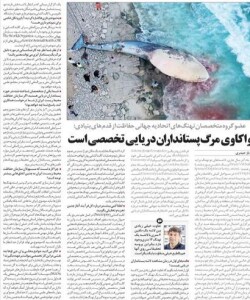En diciembre de este año, los cadáveres de dos ballenas de Bryde y un delfín girador o delfín hocico largo se encontraron en las costas de Kish (al Sur de Irán) con unos días de diferencia.
Tras encontrar los dos primeros cadáveres, que pertenecían a dos ballenas Bryd, el director general de la Organización de la Zona Franca de Kish envió una carta a la Organización de Protección Ambiental solicitando el envío de un grupo de expertos para determinar las causas de este raro fenómeno en la región y aliviar las preocupaciones de los residentes.
El problema se agravó aún más cuando el jefe del Departamento de Medio Ambiente de Kish descartó la posibilidad de muerte por arrastre o colisión con un barco cuando se encontró un tercer cadáver perteneciente a un delfín giratorio o un hocico largo. Murió de causas naturales. El caso es que hasta el momento ha habido muchas hipótesis sobre los motivos del ahogamiento y muerte de estos mamíferos marinos.
Etemad ahora busca hacer preguntas a un miembro del Grupo de Especialistas en Cetáceos de la CSE-UICN. Antonio Jesús Fernández Rodríguez.
Aquí un extracto de la entrevista:
1) What are the first steps in the similar cases?
There is a big difference between a 2 meters dolphin and 12 meters whale to handle. Logistics are very complex dealing with whales at sea or on the beach. A dolphin can be carried to an animal autopsy room but a whale in impossible but could be carried to a disposal area where a necropsy can be done by specialists on cetaceans. There are very few forensic veterinary pathologists working on whales in the world. But veterinarians could do a basic necropsy to take samples for laboratory analyses.
2) Please explain more about the whole process of starting an analysis.
A necropsy is dissection of the dead animal with a diagnostic objective, that means to get the final cause of death. Not an easy task and depends on specialization. The best perform to this kind of necropsies are veterinary pathologists. It is difficult to have such specialists in many countries or areas where the whales strand. But there are people who have experience in sampling in cetaceans or veterinarian who can do a general basic necropsy taken samples to be sent to laboratories where pathogens could be diagnosed.
3) Who must be involved in the analysis?
Field workers for transportation, field biologists and veterinarians for identification, necropsy and sampling.
Samples for infectious diseases laboratories, samples for toxicology, etc.
4) What are the basic points for sampling?
There are international protocols for necropsy and sampling. OIE organization can provide protocols for example.
5) Which experts have the right to speak about causes of death?
The competent professionals to determine causes of death in animal are veterinarians, specifically veterinary pathologists which can be accredited by national and international veterinary pathology associations.
6) Would you please tell me about one of your similar experiments?
I don’t know what you mean with this question.
7) What are your suggestions to DoE?
What is DoE? department of environment?
8) Would you care to participate with Iran officials in these cases?
I have been in Iran twice for the investigation or dolphin mass mortality in the golf. I found good people, and they want to do a god job in these cases, but they need more specialization and governmental support. It is a very specialized field. But collaboration with internal organizations and laboratories could help to approach a join project and a stranding network for the investigation of stranded cetaceans.
9) Why must officials pay attention to these incidents?
Anthropogenic causes of death are every day more frequent. Fishing interaction, ship strike…. but also infectious diseases and biotoxins are important causes of death to keep in mind.
10) Any further words?
Create regional stranding network with voluntaries (ONGs), academical institutions, local and national administration could be a good first step to start investigation of cetacean stranding network and investigation of causes of death and the same time, collecting as much scientific information as possible.
